Commentary on the consolidated balance sheet of the Eurosystem as at 31 December 2024
Eurosystem balance sheet
The annual consolidated balance sheet of the Eurosystem comprises the assets and liabilities of euro area national central banks (NCBs) and the ECB held at the year-end vis-à-vis third parties.
Claims and liabilities between Eurosystem central banks (intra-Eurosystem claims and liabilities) are netted and are therefore not visible.
The content and format of the Eurosystem’s annual consolidated balance sheet are set out in Annexes IV and VII to Guideline (EU) 2024/2941 of the European Central Bank of 14 November 2024 on the legal framework for accounting and financial reporting in the European System of Central Banks (ECB/2024/31).
Financial developments in 2024
7%
Decrease in the Eurosystem’s balance sheet
In 2024, the Eurosystem’s balance sheet total decreased by €466.7 billion to €6,420.5 billion. This reduction was due to a decrease in securities held for monetary policy purposes – mainly as a result of redemptions – and to the decline in Eurosystem refinancing operations, which was largely attributable to the maturing and early repayments of the third series of targeted longer-term refinancing operations (TLTRO III). These declines were partially offset by an increase in the euro-equivalent value of the Eurosystem’s holdings of gold, driven by the rise in the market price of gold in euro terms.
Chart 1 illustrates the main components of the Eurosystem’s balance sheet from 2020 to 2024. From 2020 to 2021 the size of the balance sheet increased, owing mainly to the monetary policy measures taken to soften the impact of the coronavirus (COVID-19) pandemic, including the launch of the pandemic emergency purchase programme (PEPP)[1], the introduction of more favourable conditions for TLTRO III operations, and the continuation of net purchases of securities under the asset purchase programme (APP)[2]. In 2022 and 2023 the Eurosystem balance sheet contracted, mainly on account of the maturing and early repayments of TLTRO III operations and, to a lesser extent, the winding down of the APP in 2023. In 2024, the balance sheet of the Eurosystem continued its gradual normalisation, with the reduction stemming primarily from the decline in securities held for monetary policy purposes (under both the APP and the PEPP) and from the maturing and early repayments of TLTRO III operations.
Chart 1
Eurosystem balance sheet by component
(EUR billions)
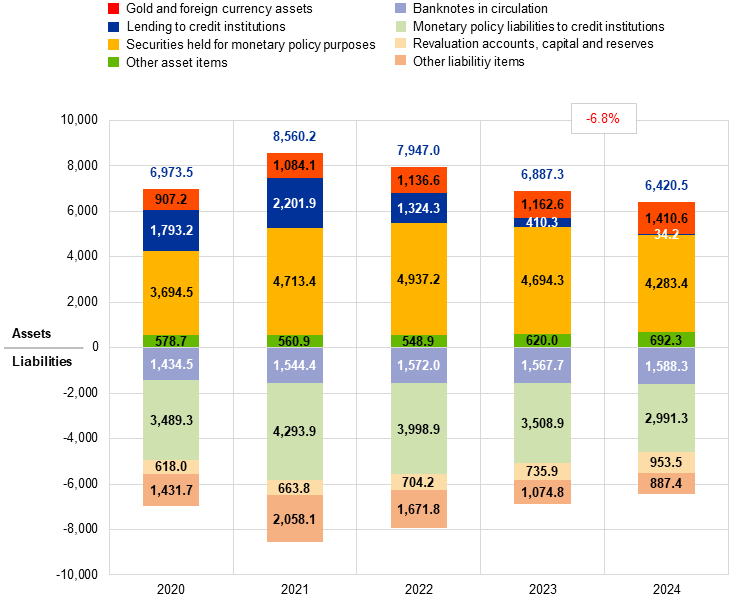
Note: The 2020-23 figures for “Other asset items” and “Revaluation accounts, capital and reserves” have been restated to reflect presentation changes introduced in the annual consolidated balance sheet of the Eurosystem in line with the new Guideline (EU) 2024/2941 of the European Central Bank of 14 November 2024 on the legal framework for accounting and financial reporting in the European System of Central Banks (ECB/2024/31).
Source: Eurosystem.
67%
Share in total assets of securities held for monetary policy purposes
Euro-denominated securities held for monetary policy purposes (asset item 7.1) constituted 67% of the Eurosystem’s total assets as at the end of 2024. Under this balance sheet item, the Eurosystem holds securities acquired under the APP, the PEPP and the terminated Securities Markets Programme (SMP).
€411.0 billion
Decrease in securities held for monetary policy purposes
In 2024, securities held by the Eurosystem for monetary policy purposes decreased by €411.0 billion to €4,283.4 billion (Chart 2). The APP accounted for 86% (or €352.8 billion) of this decrease, as reinvestments of principal payments from maturing securities in all portfolios were discontinued as of July 2023. PEPP holdings declined by €57.2 billion as a result of partial reinvestments of redemptions in the second half of 2024. Reinvestments were fully discontinued at the end of 2024. Securities held under the SMP decreased by €1.1 billion owing to redemptions.
Chart 2
Securities held for monetary policy purposes
(EUR billions)
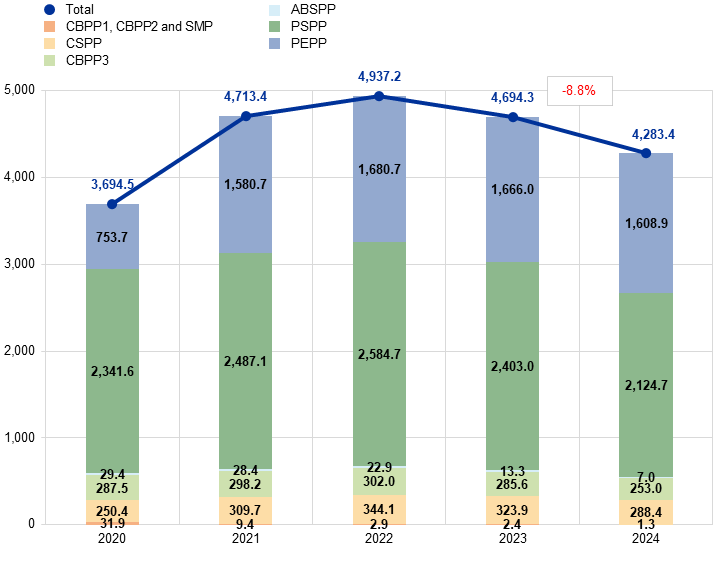
Source: Eurosystem.
Impairment tests of securities held for monetary policy purposes are conducted annually and approved by the Governing Council. In view of the outcome of the impairment tests conducted at the end of 2024, the Eurosystem did not record any impairment losses on the securities held in its monetary policy portfolios.
€376.1 billion
Decrease in Eurosystem refinancing operations
Lending to credit institutions[3] (asset item 5) decreased by €376.1 billion to €34.2 billion, owing mainly to the maturing and early repayments of TLTRO III operations (€392.3 billion). As of 31 December 2024, no TLTROs remained outstanding. Meanwhile, allotments under the three-month longer-term refinancing operations (LTROs) rose by €13.3 billion. Chart 3 displays the residual maturity breakdown of outstanding longer-term refinancing operations (asset item 5.2) as at 31 December 2024, along with a comparison to the previous year.
Chart 3
Residual maturity of outstanding longer-term refinancing operations
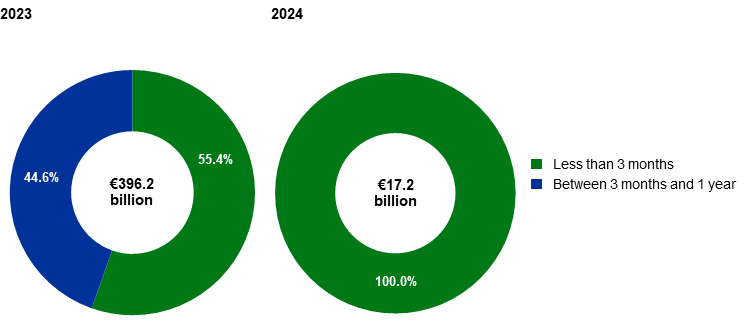
Source: Eurosystem.
€872.2 billion
Gold and gold receivables
In 2024, the value of the Eurosystem’s gold and gold receivables (asset item 1) increased by €223.0 billion to €872.2 billion (Chart 4) owing to the rise in the market price of gold in euro terms. This increase also led to an equivalent rise in the Eurosystem’s gold revaluation accounts (liability item 11).
Chart 4
Gold holdings and gold prices
(left-hand scale: EUR billions; right-hand scale: euro per fine ounce of gold)
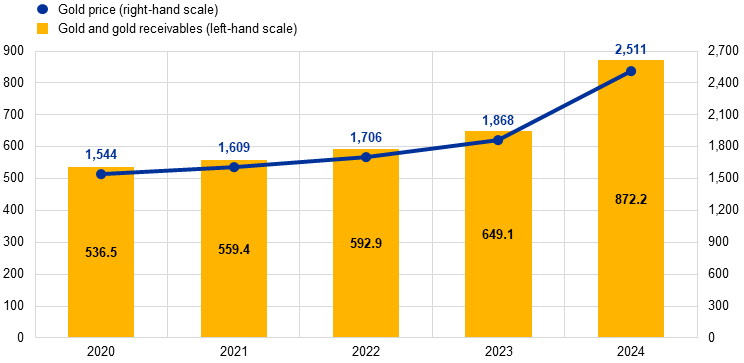
Source: Eurosystem.
The net position of the Eurosystem in foreign currency (asset items 2 and 3 minus liability items 7, 8 and 9) rose by €28.3 billion in euro terms to €343.8 billion. The effect of the revaluation of assets and liabilities denominated in foreign currency accounted for €16.0 billion of this increase. The remaining €12.3 billion resulted from customer and portfolio transactions. The Eurosystem’s foreign currency holdings comprise mainly US dollars, special drawing rights (SDRs), pounds sterling and Japanese yen.
In accordance with the Eurosystem’s harmonised accounting rules, gold, foreign exchange and financial instruments (other than securities classified as held-to-maturity, non-marketable securities and securities held for monetary policy purposes) are revalued at market rates and prices. The gold price and the principal exchange rates used for the revaluation of year-end balances of the main foreign currency holdings, as well as those from the previous year-end, were as follows:
Chart 5 illustrates the movements in gold prices and main foreign exchange rates against the euro from 2020 to 2024.
Chart 5
Main foreign exchange rates and gold price
(percentage changes vis-à-vis 2020, year-end data)
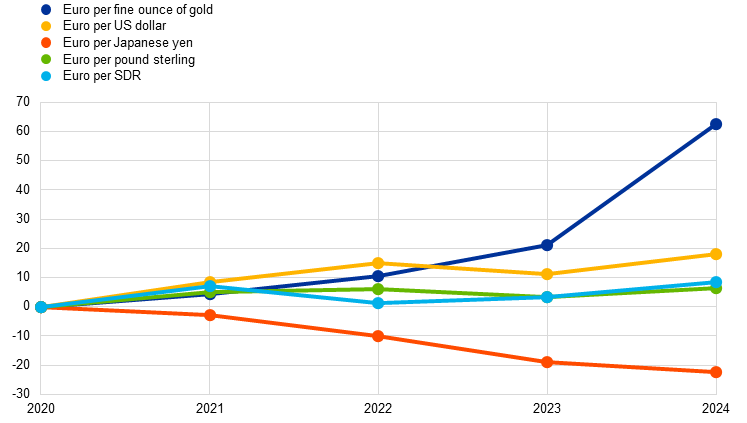
Source: Eurosystem.
1.3 %
Increase in banknotes in circulation
In 2024, banknotes in circulation[4] (liability item 1) increased by 1.3% (or €20.6 billion) to reach a total of €1,588.3 billion.
Base money, which comprises banknotes in circulation as well as current accounts (liability item 2.1) and the deposit facility (liability item 2.2), fell by €496.9 billion to €4,579.6 billion in 2024. This reduction was mainly driven by the decline in outstanding Eurosystem refinancing operations and the maturing of securities held under the APP and the PEPP.
Liabilities to other euro area residents denominated in euro (liability item 5) decreased by €100.0 billion to €203.8 billion as a result of a reduction in deposits of governments and other euro area residents, including financial institutions not subject to minimum reserve requirements. Liabilities to non-euro area residents denominated in euro (liability item 6) fell by €39.6 billion to €242.4 billion. This was a continuation of the downward trend resulting from the 1 May 2023 remuneration adjustment of euro area government deposits and deposits held under the Eurosystem reserve management services (ERMS) framework[5]. In addition, remuneration of most other non‑monetary policy deposits was aligned as of 1 December 2024.[6] These changes incentivised a gradual and orderly reduction of such deposits within the Eurosystem.
Revaluation accounts (liability item 11) increased by €237.5 billion to €872.3 billion in 2024, primarily reflecting the rise in the revaluation of gold (Chart 6).
Chart 6
Breakdown of revaluation accounts
(EUR billions)
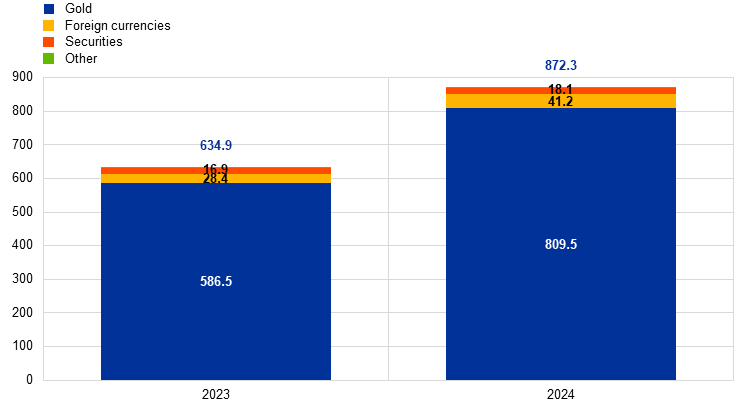
Source: Eurosystem.
Capital and reserves (liability item 12) decreased by €19.9 billion to €81.1 billion in 2024. This change was partially due to a reclassification of accumulated losses carried forward as a negative balance to this liability item from other assets (asset item 9).[7] Some Eurosystem central banks maintain provisions (part of liability item 10) for risks that have not materialised.[8] These provisions were €56.8 billion at the end of 2024, down from €73.1 billion at the end of 2023. This decrease was due to the release of part of these provisions to cover financial risks that materialised during 2024.
The PEPP was a temporary asset purchase programme of private and public sector securities initiated in March 2020 to counter the serious risks that the COVID-19 pandemic posed to the monetary policy transmission mechanism and the euro area outlook. Reinvestments under the PEPP were fully discontinued at the end of 2024. Further details can be found on the ECB’s website under Pandemic emergency purchase programme.
The APP consisted of the third covered bond purchase programme (CBPP3), the asset-backed securities purchase programme (ABSPP), the public sector purchase programme (PSPP) and the corporate sector purchase programme (CSPP). Reinvestments under the APP were fully discontinued at the end of June 2023. Further details can be found on the ECB’s website under Asset purchase programmes.
More information about lending can be found on the ECB’s website under Open market operations.
Information on the development of banknotes in circulation since 2002, broken down by denomination, can be found on the ECB’s website under Banknotes and coins circulation.
More information can be found on the ECB’s website under ECB adjusts remuneration of certain non‑monetary policy deposits as of 1 May 2023.
More information can be found on the ECB’s website under ECB confirms remuneration ceiling for euro area government deposits and adjusts remuneration of other non-monetary policy deposits.
This reclassification reflects presentation changes introduced in the annual consolidated balance sheet of the Eurosystem in line with the new Guideline (EU) 2024/2941 of the European Central Bank of 14 November 2024 on the legal framework for accounting and financial reporting in the European System of Central Banks (ECB/2024/31).
The creation of these provisions is subject to the legal frameworks of the individual central banks. Provisions related to Eurosystem monetary policy operations are not included.


